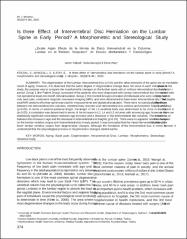| dc.contributor.author | Köksal, Vaner | |
| dc.contributor.author | Avnioğlu, Seda | |
| dc.contributor.author | Atay, Emre | |
| dc.date.accessioned | 2021-05-05T22:11:51Z | |
| dc.date.available | 2021-05-05T22:11:51Z | |
| dc.date.issued | 2020 | |
| dc.identifier.issn | 0717-9367 | |
| dc.identifier.uri | https://doi.org/10.4067/S0717-95022020000200374 | |
| dc.identifier.uri | https://hdl.handle.net/20.500.12933/181 | |
| dc.description | 2-s2.0-85079181298 | en_US |
| dc.description.abstract | The degeneration of the Lumbar Intervertebral Disc (LIVD) and the other elements of the spine are an inevitable result of aging. However, it is observed that the same degree of degenerative change does not occur in each individual. In the present study, the purpose was to compare the morphometric changes on the lumbar spine with or without intervertebral disc herniation in early period. Group 1 (the Patient Group) consisted of the patients who were diagnosed with lumbar intervertebral disc hernia and who were not operated at least one month clinical duration. Group 2 (the Control Group) consisted of individuals who were selected randomly, had only back pain, underwent magnetic resonance imaging (MRI), and were determined to have intact intervertebral disc. The sagittal and axial MRI sections of lumbar spine was used for measurements and statistical evaluation. There were no statistically significant differences between the intervertebral disc volumes, vertebral body volumes and intervertebral disc anterior and posterior heights of Group 1 and 2 (p>0.05). In terms of anterior-posterior length, the length of the L5 vertebral body was determined to be more in the Patient Group (p<0.05). A correlation was determined in terms of the increase in L2, L4 and L5 volumes with increasing age; however, there were no statistically significant correlations between age increase and a decrease in the intervertebral disc volumes. There were no correlations between the increase in age and the decrease in intervertebral disc heights (p>0.05). There were no apparent relations between the change on the lumbar vertebra corpus and intervertebral disc in early period. It was concluded that the intact intervertebral disc could protect the lower lumbar vertebra corpus from degenerative changes. Although the herniation of the intervertebral disc is newly formed, it is understood that the physiological process or morphometric changes started earlier. © 2020, Universidad de la Frontera. All rights reserved. | en_US |
| dc.language.iso | eng | en_US |
| dc.publisher | Universidad de la Frontera | en_US |
| dc.rights | info:eu-repo/semantics/openAccess | en_US |
| dc.subject | Aging | en_US |
| dc.subject | Back pain | en_US |
| dc.subject | Degeneration | en_US |
| dc.subject | Intravertebral Disc | en_US |
| dc.subject | Lumbar | en_US |
| dc.subject | Morphometry | en_US |
| dc.subject | Stereology | en_US |
| dc.subject | Vertebral body | en_US |
| dc.title | Is there Effect of Intervertebral Disc Herniation on the Lumbar Spine in Early Period? A Morphometric and Stereological Study
¿Existe Algún Efecto de la Hernia de Disco Intervertebral en la Columna Lumbar en el Período Temprano? Un Estudio Morfométrico Y Estereológico | en_US |
| dc.type | article | en_US |
| dc.department | AFSÜ, Tıp Fakültesi, Temel Tıp Bilimleri Bölümü, Anatomi Ana Bilim Dalı | |
| dc.contributor.institutionauthor | Atay, Emre | |
| dc.identifier.doi | 10.4067/S0717-95022020000200374 | |
| dc.identifier.volume | 38 | en_US |
| dc.identifier.issue | 2 | en_US |
| dc.identifier.startpage | 374 | en_US |
| dc.identifier.endpage | 381 | en_US |
| dc.relation.journal | International Journal of Morphology | en_US |
| dc.relation.publicationcategory | Makale - Uluslararası Hakemli Dergi - Kurum Öğretim Elemanı | en_US |
















